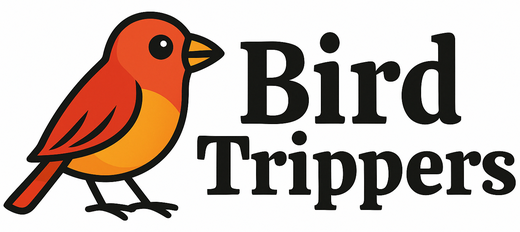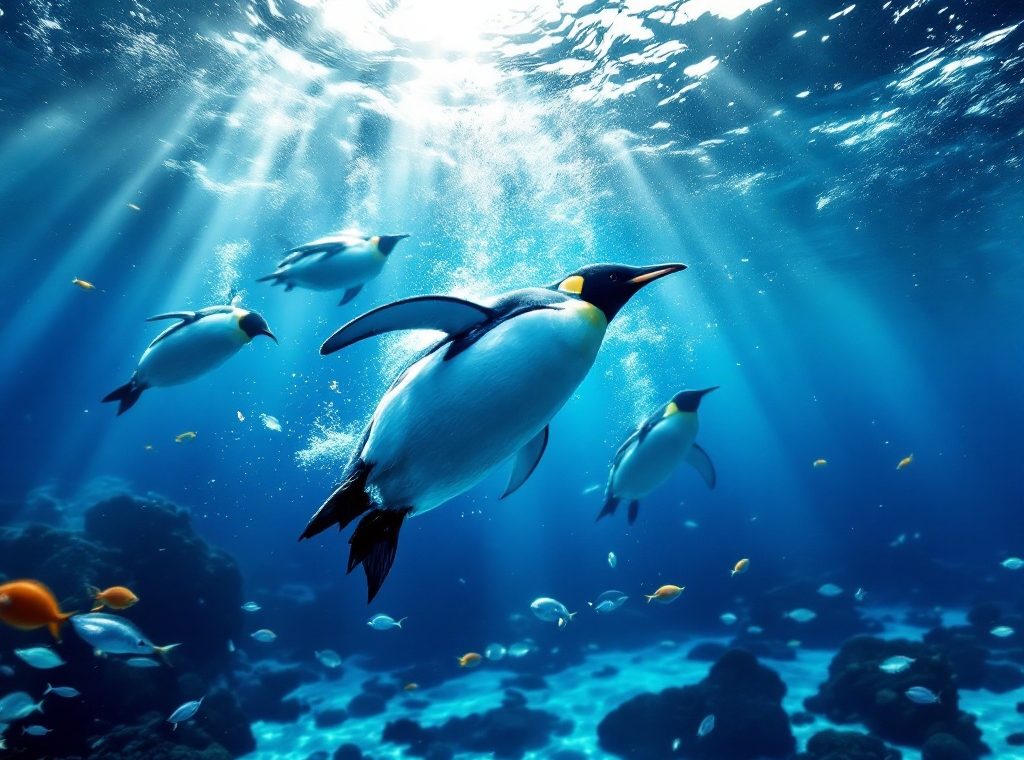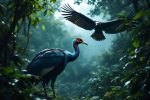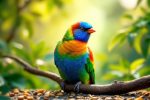Penguins as Great Swimmers: How Long Can Penguins Hold Their Breath
Dive into the incredible world of penguins and their breathtaking underwater abilities! Did you know emperor penguins can hold their breath for a staggering 27 minutes, plunging to depths exceeding 500 meters? Discover the secrets behind these avian athletes, from their streamlined bodies and specialized locomotion like porpoising, to their efficient oxygen storage and remarkable physiological adaptations. Explore the diverse diving capabilities of various penguin species, including king and African penguins, and learn how their breath-holding prowess makes them expert hunters of krill, squid, and fish. Uncover the mysteries of the deep and explore the fascinating world of penguin diving – read on!
Important information
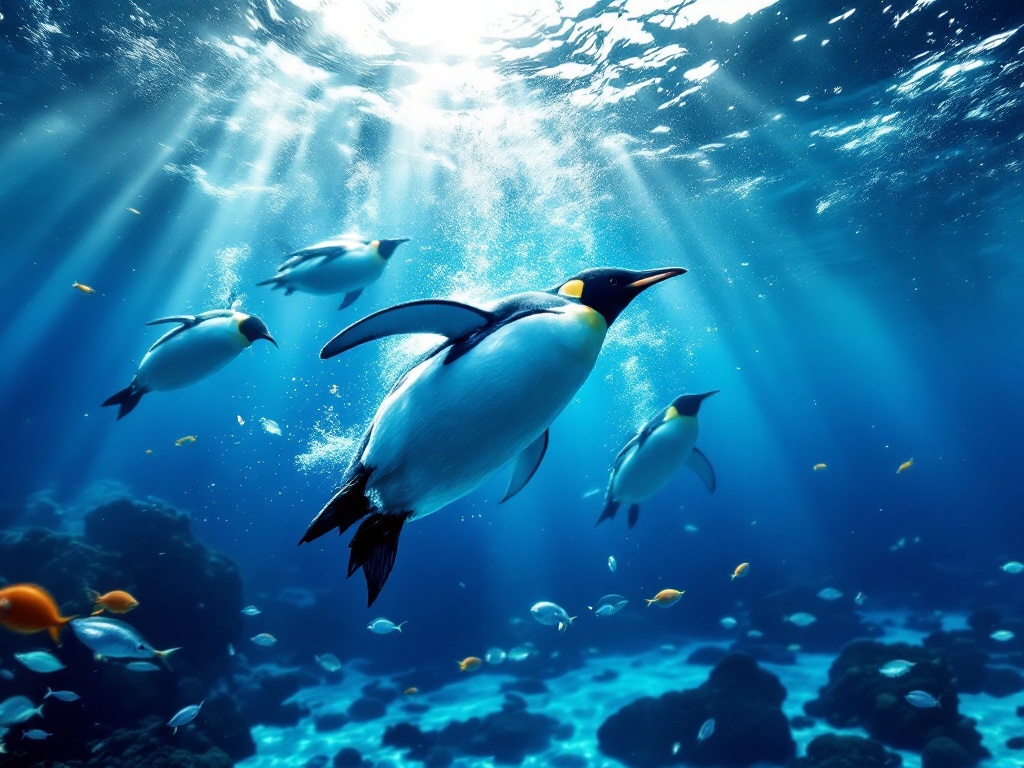
- Emperor penguins can hold their breath for an astonishing 27 minutes and dive to depths exceeding 500 meters.
- Most penguin species can hold their breath underwater for 6 to 12 minutes.
- Penguins’ streamlined bodies and specialized techniques like porpoising help them conserve oxygen and energy while diving.
- Physiological adaptations, such as slowed heart rate (bradycardia) and efficient oxygen storage in blood and muscles (using myoglobin), enable extended dives.
- Penguins primarily dive to hunt for food, including krill, squid, and fish.
Penguins as Great Swimmers: How Long Can Penguins Hold Their Breath
Penguins are incredible divers, holding their breath for astonishing durations. Emperor penguins can submerge for an astounding 27 minutes. Other species, like some king penguins, can hold their breath for up to 20 minutes. Most penguin species manage between six and 12 minutes underwater. African penguins typically hold their breath for the shortest amount of time, between two and three minutes. Several factors influence a penguin’s breath-holding capacity, including species, water temperature, dive depth, and food availability.
Aquatic Adaptations Enabling Penguins to Hold Their Breath
Penguins are remarkably adapted for underwater life. Their physiology allows them to store oxygen efficiently in their blood and muscles, with myoglobin acting like a built-in oxygen tank. Their streamlined bodies minimize water resistance, enabling effortless movement and conserving vital energy. Furthermore, penguins employ specialized locomotion techniques like porpoising, reducing energy expenditure and maximizing oxygen use during deep dives. These adaptations make them true aquatic athletes. Here’s a closer look at these adaptations:
Oxygen Storage
Penguins store oxygen efficiently in their blood and muscles. Myoglobin, a protein in their muscles, acts like a built-in oxygen tank, allowing them to stay submerged for extended periods.
Streamlined Bodies
Their streamlined bodies minimize water resistance, enabling effortless movement through the water and conserving vital energy for hunting and diving.
Specialized Locomotion
Penguins use techniques like porpoising, leaping out of the water while swimming, to reduce energy expenditure and maximize oxygen use during deep dives.
Physiological Adaptations for Breath-Holding
Penguins have remarkable breath-holding abilities due to efficient oxygen storage in their lungs and a specialized circulatory system. When diving, their heart rate slows down, conserving oxygen and allowing them to stay underwater for extended periods. Emperor penguins can significantly reduce their heart rate during dives, optimizing oxygen use for long underwater hunts. This adaptation makes them highly effective predators in the icy Antarctic waters.
Streamlined Design and Hydrodynamic Body Shape
Penguins, built for an aquatic life, are exceptionally adept swimmers. Their streamlined, hydrodynamic bodies minimize drag, enabling efficient movement through the water. Extended breath-holding capabilities further enhance their underwater prowess, allowing them to hunt with ease.
Role of Aquatic Locomotion in Breath-Holding
Penguins are masters of underwater movement. Their streamlined bodies and powerful flippers enable effortless gliding, conserving precious energy and oxygen for longer dives. This increased underwater endurance significantly boosts their hunting success. Their remarkable agility is also crucial, enabling them to chase and capture prey with impressive skill. Penguins can hold their breath for extended periods, further enhancing their hunting prowess.
Diving Abilities and Techniques in Penguins
Penguins are expert divers, employing various techniques to thrive underwater. They sometimes dive in unison, while other times they “porpoise”—leaping out of the water while swimming to breathe and conserve energy on long journeys. Dive depth and duration vary by species. Emperor penguins are the undisputed champions, plunging to incredible depths exceeding 500 meters and holding their breath for an astounding 27 minutes. King penguins manage a respectable 4 to 6 minutes, while African penguins typically stay submerged for 2 to 3 minutes. These dives primarily serve to hunt for food, targeting krill, squid, and fish. Synchronized diving, often observed in groups, may confuse predators or enhance hunting success.
Dive Depth and Duration
Emperor penguins are champion divers, plunging to incredible depths of 565 meters and holding their breath for an astounding 27 minutes. King penguins, while also impressive, typically dive between 100 and 300 meters, with breath-holds lasting four to six minutes. African penguins, in contrast, prefer shallower dives of 20 to 70 meters for two to three minutes.
Emperor Penguin
Dive Depth: 565 meters
Breath-Hold: 27 minutes
King Penguin
Dive Depth: 100-300 meters
Breath-Hold: 4-6 minutes
African Penguin
Dive Depth: 20-70 meters
Breath-Hold: 2-3 minutes
Synchronized Diving and Porpoising
Synchronized diving is a clever tactic penguins use to confuse predators and effectively hunt prey.
Porpoising, leaping from the water while swimming, is another remarkable skill. This behavior conserves energy by reducing drag, allowing penguins to travel greater distances. Furthermore, porpoising enables more frequent breathing without interrupting their swim, a truly advantageous adaptation.
Diving for Food and Prey Capture
Penguins are expert divers, hunting for fish, squid, and krill beneath the waves. Their streamlined bodies and powerful flippers make them remarkably effective hunters, allowing them to move swiftly through the water.
Physiological Responses During Dives
During dives, a penguin’s heart rate drops significantly, a phenomenon known as bradycardia, which conserves vital oxygen. Blood flow is prioritized to essential organs like the brain and heart.
Penguin muscles have a high tolerance for low oxygen levels (hypoxia), enabling them to function even in oxygen-deprived environments. This remarkable ability is enhanced by myoglobin, an oxygen-storing protein in their muscles, providing an extra power source for extended underwater excursions.
Heart Rate and Oxygen Conservation
Penguins have a remarkable adaptation for effective hunting: during dives, their heart rates slow down significantly. This phenomenon, called bradycardia, conserves vital oxygen, allowing them to stay underwater longer while hunting for food. This ability is crucial to their survival.
Oxygen Stores and Hypoxia Management
Penguins are exceptional divers due to several remarkable adaptations. They store oxygen in their muscles and blood, bound by myoglobin and hemoglobin, respectively, enabling extended underwater excursions. To conserve oxygen, they lower their heart rate and restrict blood flow to non-essential organs during dives, prioritizing the brain and heart. Their high tolerance for carbon dioxide and low blood pH allows them to withstand hypoxia (low oxygen levels). This makes them perfectly suited for their aquatic world.
Species-Specific Breath-Holding Durations
Penguins are remarkable divers, but their breath-holding abilities vary greatly. Most penguins can stay submerged for 6 to 12 minutes, while emperor penguins are true champions, boasting an incredible 27-minute limit.
Other penguin species also exhibit impressive breath-holding capabilities. Some unnamed penguins can hold their breath for up to 20 minutes. King penguins typically manage 4 to 6 minutes underwater, while African penguins have a shorter breath-holding capacity of only 2 to 3 minutes.
General Breath-Holding Capacity: 6 to 12 Minutes
Penguins are remarkable divers, capable of holding their breath for six to twelve minutes, ample time to hunt krill, squid, and fish. These underwater forays are crucial to their survival.
Emperor Penguins: Up to 27 Minutes
Emperor penguins are remarkable divers, capable of holding their breath for an astonishing 27 minutes. This extraordinary ability allows them to plunge into the ocean depths, searching for fish and squid. Their streamlined bodies and specialized physiology, combined with efficient diving techniques, contribute to these extended underwater forays. These impressive dives can reach depths of over 1,700 feet, where they hunt for prey in the cold, dark waters.
Extended Breath-Holding in Some Species: Up to 20 Minutes
Penguins are incredible divers, some holding their breath for an astonishing 20 minutes. This remarkable ability allows them to plunge into the depths, searching for the food crucial to their survival.
King Penguins: Typically 4 to 6 Minutes
King penguins, known for their deep dives, typically hold their breath for only four to six minutes. This shorter submersion time is directly related to their foraging habits in shallower waters, where quick dives are more efficient.
African Penguins: 2 to 3 Minutes
African penguins can hold their breath for an impressive two to three minutes, allowing them to dive deep and hunt for food underwater.
